Gluten free guide to Portuguese food

As Lisbon’s dining scene is rather vast, you will easily come across a lot of gluten-free labeled options in restaurants all over town, and there’s even some fabulous fully gluten-free restaurants.
Most establishments catering to celiacs and those who’d rather follow a diet with low or no gluten consumption end up serving a menu of internationally inspired dishes, and don’t necessarily focus all that much on Portuguese food. Luckily, there are a lot of naturally gluten-free traditional Portuguese dishes which you can eat and which will be a good representation of our food heritage. We sure love our bread and pastries, but Portugal’s national cuisine is also heavily defined by recipes such as rice dishes, fish grills served with potatoes and vegetables, meat and legumes stews, and lots of vegetable soups which any gluten-free, vegetarian and even vegan person can easily enjoy in most eateries around the country. If you want to be 100% safe, inquire if they use store-bought bouillon for the soups, but most frequently this will not be the case.
The Associação Portuguesa de Celíacos, the national association for support of those with celiac disease in Portugal, has put together a quick statement which you can use to communicate your needs to restaurants in Portugal, in case English is not spoken – check these useful words here! The main thing you should learn how to say in Portuguese is sem glúten, that is, gluten free, which most places serving food, at least in urban areas, will understand these days. When it comes to packaged products with printed ingredient information, the official sentence to look out for would be isento de glúten or livre de glúten.
There are a lot of online resources which will point you towards gluten-free establishments, particularly concentrating around the cities of Lisbon and Porto, but our goal here is to make your life easier while visiting regular restaurants, which is exactly where you’ll be able to taste the genuine flavors of Portuguese cuisine. So if you’re a celiac traveler coming to Portugal, or if you merely prefer not to eat gluten, follow these simple tips to navigate the world of typical gluten-free Portuguese food.
Naturally gluten-free traditional Portuguese foods
Skip the bread and focus on other wheat-free Portuguese appetizers
When you dine out in Portugal, you’ll notice that whether you ask for it or not, chances are a bread basket will land on your table. Don’t expect most restaurants to have a gluten-free alternative to these baked goods. Instead, ask your waiter to kindly take away the bread and focus on other common Portuguese appetizers, which can include tremoços (lupin beans in brine, usually served complimentary with beers), cheese and cured meats as part of simpler spreads, or more elaborate petiscos (aka Portuguese tapas) such as octopus salad, garlic prawns, clams in white wine sauce, and more.
One of the popular gluten-free starters which you can definitely enjoy in Portugal would be pastéis de bacalhau, that is shredded cod and potato fritters. If you’re not sure if a given restaurant fries these in vegetable oil contaminated with other foods, you can at least eat them at Casa Portuguesa do Pastel de Bacalhau, with shops both in Lisbon and Porto, which specializes in making just this one fritter.
Other than this fried snack, avoid fritters which will generally be coated in breadcrumbs, such as rissóis and croquetes, or that are battered and deep-fried, like pataniscas cod cakes and peixinhos da horta, the portuguese predecessor of Japanese tempura.
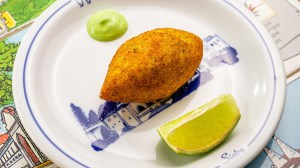
Rice dishes: arroz de marisco, duck rice and more!
Most gluten-free people will often be on the lookout for rice-based foods. The good news when you visit our country is that many of our most typical recipes are actually rice dishes, so this means that you will not miss out on sampling the essence of Portuguese cuisine. Before you order any of these, always confirm with your server that store-bought stock, such as the one by popular brand Knorr which does contain gluten, hasn’t been used to prepare:
- Arroz de marisco (Portuguese seafood rice);
- Arroz de polvo (saucy octopus rice);
- Arroz de pato (oven-baked duck rice, topped with chorizo);
- Arroz de lingueirão (soupy rice with razor clams);
- Arroz de tamboril (soupy rice with monkfish);
- Arroz de cabidela (rice with braised chicken and chicken blood);
- Arroz de lampreia (rice with lamprey and red wine, mostly found in the pre-Spring season in the northern Minho region).

Fresh charcoal grills with potatoes and vegetables
When you eat out in Portugal you’ll notice that most Portuguese main dishes bring together on a plate different ingredients which are easy to identify and, thus, make the life of a celiac traveler much less complicated. We’re particularly talking about grills served with sides like potatoes and vegetables. Grilled mollusks like squid, cuttlefish and octopus, as well as grilled fish (particularly sardines during summer months), are some of Lisbon’s most quintessential meals and something you’ll find a little all over the country. While grilled fish is usually accompanied by boiled potatoes and a few vegetables, grilled meat, such as the succulent Iberian black pork loin, is most commonly paired with fries and a little side salad. The simplicity of Portuguese cuisine can actually help you eat out in Portugal while fully avoiding gluten.
If you like smoky grills, scan the restaurant menu for dishes like:
- Peixe grelhado (grilled fish – depending on the catch of the day);
- Lulas or chocos grelhados (grilled squid or cuttlefish, with potatoes and vegetables);
- Sardinhas assadas (grilled sardines, usually served with boiled potatoes and a roasted bell pepper salad called salada de pimentos);
- Polvo à lagareiro (roasted octopus and potatoes drenched in garlicky olive oil);
- Lulas à Algarvia (squid with potatoes, garlic and fresh herbs);
- Espetadas (Portuguese skewers most typical in Madeira, which may contain meat, seafood or a mix of both);
- Secretos de porco preto or lagartos de porco preto grelhados (strips of grilled Iberian black pork, which usually come with fries and salad);
- Grelhada mista (mixed meat grill with several cuts of pork, chicken and perhaps beef, generally served with potato fries).
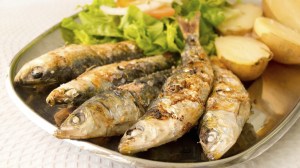
Piri-piri chicken, leitão and other Portuguese BBQ dishes
Lovers of smoky flavors have it good in Portugal, as most BBQ dishes, such as the uber popular piri-piri chicken, known in Portugal as frango de churrasco, are naturally gluten-free. The meat doesn’t take much more than salt, pepper, lemon and olive oil. Sauces such as spicy piri-piri are usually added at the end of the cooking process, or even right at the table, and are also gluten-free, not including more than chili peppers, oil, water, garlic and a few spices.
If you’re most inclined to try an iconic pork dish, be happy to know that leitão à Bairrada, spit-roasted suckling pig traditional from the Bairrada region, is also gluten-free, as so are the straightforward chips that come with it in a rather unadorned manner.
Other barbeque recipes typical in churrascarias (that is, BBQ and grill restaurants) across Portugal include:
- Piano or entrecosto no churrasco (ribs);
- Chouriço assado (pork and paprika cured sausage);
- Salsicha crioula (creole pork sausages);
- Posta Mirandesa (a large veal steak from the Trás-os-Montes province);
- Costeletas de novilho or costeletas de porco (veal or pork chops);
- Bife (simply, a beef steak).
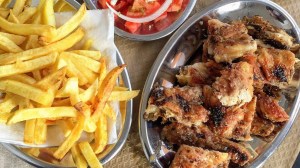
Bacalhau: the faithful gluten-free friend
Much has been said about the Portuguese love (or shall we say obsession?) for salted cod, known in Portugal as bacalhau. This ingredient affectionately referred to as “the faithful friend”, as it is one of those things Portuguese people tend to always keep in their pantries, is an essential element to some of Portugal’s most famous recipes. Luckily, salted cured cod is naturally gluten-free, and so are many of the recipes that revolve around it. Some bacalhau dishes you should not order when following a gluten-free diet include bacalhau com broa (oven roasted cod with a cornbread crust), bacalhau espiritual (cod au gratin in the oven with vegetables and bechamel), bacalhau à Minhota (fried cod, which may involve coating the fish with flour prior to cooking), and even bacalhau com natas (this cod and cream oven baked dish may include bechamel instead of actual cream, so you’re better off choosing another dish).
Some of the delicious naturally gluten-free salted cod dishes include:
- Bacalhau com todos (boiled cod with boiled sides such as chickpeas, potatoes, veggies and leafy greens);
- Bacalhau à lagareiro (roasted cod with potatoes and garlic olive oil);
- Bacalhau à Brás (shredded cod scrambled with fried matchstick potatoes, onions and olives);
- Bacalhau à Ze do Pipo (cod covered with creamy mashed potatoes and topped up with mayonnaise, au gratin in the oven);
- Bacalhau à Gomes de Sá (a straightforward boiled cod casserole, with potatoes, boiled eggs and olives).
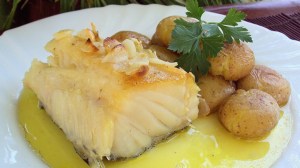
Hearty meat stews and one-pot wonders
Stews are one of the backbones of Portuguese cooking, which is rooted in peasant cuisine which makes the most of the once limited amounts of animal protein, and bulks up the dishes with potatoes, vegetables and legumes. This is how recipes like feijoada, our typical meats and beans stew, favas com entrecosto, broadbean stew with ribs, or cozido à Portuguesa, which we could translate as Portuguese meats stew, came about. The ingredients that make it to the pot when preparing these recipes can vary from region to region or, simply depending on who is the cook. Because the world of Portuguese cured meats includes sausages like alheira and farinheira, which may look gluten free but are not (please see more details below), it’s important to ask if they are a part of the dish before you order. In the north of Portugal, and in particular in the province of Trás-os-Montes, where alheira and farinheira come from, it is indeed very likely that they are both included in feijoada, cozido or similar stews such as rancho, which not only includes cuts of meat, potatoes and all sort of vegetables, but also includes pasta and is therefore off limits for celiacs. But elsewhere in Portugal, alheira and farinheira don’t necessarily make it to the pot – simply ask and don’t be shy to assert your dietary needs, as the staff of the restaurant may be tempted to simply not include these cuts of meat on your serving, but it’s crucial to understand if what you are about to eat was cooked alongside alheira or farinheira back in the kitchen.
Other nourishing recipes which are gluten-free and you can generally safely order in Portugal include:
- Rojões (fried chunks of pork meat with fried cubed potatoes, particularly common in the north of Portugal);
- Tripas à moda do Porto (beef tripe and white beans stew, typical from the city of Porto and known elsewhere in Portugal as dobrada com feijão branco – usually served with a side of steamed white rice);
- Carne de porco à Alentejana (fried pork meat with clams and fried potatoes);
- Cabrito or borrego assado (oven-roasted goatling or lamb, with potatoes);
- Coelho à caçador (stewed rabbit with a side of potatoes).
When navigating the world of Portuguese braised meat dishes, keep away from those that include the word ensopado on the name. Ensopados, such as ensopado de borrego, a typical lamb dish from the Alentejo, are saucy dishes usually served atop bread slices which soak up the juices of the stew, hence are certainly not gluten-free.
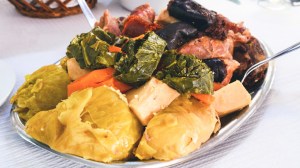
Plenty of seafood: steamed, grilled and in more festive dishes
We’ve come up with our top 10 seafood to try in Portugal, and we can safely say that you can eat any of these on a gluten-free diet. Most seafood in Portugal is consumed steamed, grilled or sauteed with olive oil and garlic and, as such, it does not contain gluten. Skip the bread which is often served to soak up with juices, particularly with dishes such as clams Bulhão Pato style, and you’re good to go!
More elaborate and festive (and generally gluten-free) dishes you can taste in Portugal include:
- Caldeirada de peixe (Portuguese fishermen stew);
- Cataplana (steamed seafood inside of a cataplana vessel);
- Feijoada de choco (sea tasting stew with butter beans and cuttlefish strips);
- Feijoada de búzios (beans stew with whelk, aka, sea snails);
- Xerém de conquilhas (corn porridge with cockles, very typical in the southern region of the Algarve).
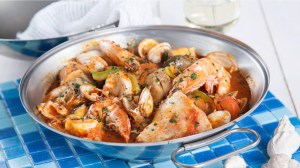
Portuguese desserts which are indeed gluten-free
If most Portuguese cakes found in cafés and pastry shops are wheat based, at least when it comes to pudding, there are so many gluten-free options which will allow you to end your traditional Portuguese meal on a sweet note. Most Portuguese dessert recipes are egg and sugar based, such as our vast range of conventual sweets. If you’re a celiac, avoid Portuguese sweets such as bolos (cakes), tortas (pies), tartes (tarts), filhós and malassadas (sweet fried dough, somehow similar to doughnuts), aletria (a sweet similar to rice pudding but prepared with angel hair pasta), serradura (layered dessert of condensed milk and cream with crumbled biscuits), and sericaia (Alentejo’s most beloved dessert, which is basically a moist cinnamon cake with preserved plums).
These are the most notable gluten-free typical Portuguese desserts you can focus on:
- Pudim flan, pudim de ovos and pudim de gemas (Portuguese crème caramel with caramelized sugar sauce);
- Pudim Abade de Priscos (bacon pudding, with copious amounts of eggs, sugar, and yes… bacon!)
- Mousse de chocolate (a straightforward chocolate mousse, which most Portuguese tascas serve);
- Arroz doce (sweet rice pudding with milk, egg yolks and a touch of cinnamon and lemon zest);
- Molotov (egg whites pudding, conventionally served with either caramel topping or creamy egg jam known in Portuguese as doce de ovos);
- Baba de camelo (cooked condensed milk mousse, which literally translates as “camel’s drool” because of its gooey appearance);
- And fruit based sweet dishes such as maçã assada (baked apples) and peras bêbedas (pears poached in red wine).

Portuguese foods that look gluten-free but are not:
Besides obvious Portuguese dishes you should avoid when following a gluten-free meal plan (think cakes, sandwiches, as well as several popular Portuguese dishes which are prepared with old bread like migas and açordas), there are a few other foods which may look innocent but are not!
Portuguese sausages alheira and farinheira
In the vast range of Portuguese cured meats, known in Portuguese as enchidos, there are two which stand out as not gluten-free: alheira and farinheira. Besides meat, fat and condiments, both these sausages contain wheat for bulking and shaping. Alheira is stuffed with bread, while farinheira is molded with the aid of flour. Even morcela, Portuguese blood sausage, may include a little flour for binding all the ingredients. Portuguese black pudding is most commonly prepared with rice, but the restaurant which serves it will hardly be able to confirm this unless they make it themselves (which is usually not the case), so we’d suggest you simply skip these and make sure they are not added to any of the meats stews we mention above.
There are many other Portuguese enchidos you can try, so simply concentrate on those, which include delicacies like presunto (cured ham), chouriço (chorizo) and paio (smoked pork loin), just to name a few. The happy news is that when you order a charcuterie platter in Portugal, things like farinheira, alheira or morcela, will generally not be featured, so you can safely enjoy your cured meats tasting.
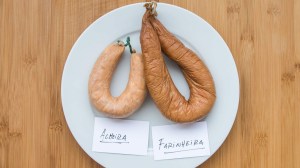
Cornbread broa
Broa is one of the most quintessential breads from the north of Portugal, particularly from the Minho region, and it is a staple served with soups such as caldo verde. Even though you could translate broa as cornbread, and it is often sold in Portugal under the name pão de milho or broa de milho, keep in mind that it isn’t only made with corn flour. White or yellow, broa’s recipe mixes corn and wheat flours and thus is not gluten-free.
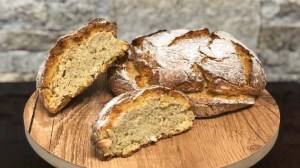
Bolo de arroz rice muffins
Bolo de arroz, aka rice muffin, is one of Portugal’s essential cakes you’ll find in most pastelarias across the country. It’s most commonly eaten for breakfast as it is spongy and ideal to dunk in milky drinks. But don’t be fooled by its name which may lead you to think that this pastry is prepared with rice flour alone. Indeed it contains a portion of rice flour, but it also has wheat flour, which explains its fluffiness. Just like most typical cakes you’ll see decorating the counters of Portuguese cafés, bolo de arroz is definitely not gluten-free.

The custard inside pastel de nata
You wouldn’t be the first person to eat the filling of a Portuguese custard tart and leave the puff pastry casing around it. Some folks do this because they simply like the creamy filling best, while others may attempt to dissect Portugal’s most iconic sweet for the sake of avoiding gluten. If this is the case, please keep in mind that the custard also has wheat, as it is normally prepared with milk thickened with all purpose flour. As such, if you are sensitive or allergic to gluten, we’d rather recommend heading to Pastelaria Zarzuela (Rua Bernardino Costa 21, 1200-052 Lisboa), a Lisbon bakery which sells fully gluten-free (and vegan!) pastéis de nata pictured above; Com Cuore (Rua Trindade Coelho entrada 10 loja 11, 4050-618 Porto) a gluten-free restaurant and bakery in Porto – hello gluten-free Francesinha!; Batardas (Praceta Lagoa de Óbidos 38, 2775-722 Parede), a gluten-free kitchen near Cascais; Bonna Pastelaria (Rua Dom Paio Mendes 3, 4700-419 Braga) in the northern city of Braga; or even purchase them frozen to bake at home, from the national chain of supermarkets Pingo Doce.

Leite creme, aka Portuguese crème brûlée
Following the same logic as the filling for pastel de nata, leite creme is a custard dessert which may or may not be gluten-free, depending on the cook. While most leite creme recipes call for cornstarch to thicken the custard, some people do use wheat flour for this purpose. If you are tempted, be sure to ask your waiter and, if they’re not so sure about the answer, skip leite creme all together in favor of other naturally gluten-free Portuguese desserts such as the ones we recommend above.

We can assure you that having intolerance to gluten is not a deal breaker if you wish to explore most traditional Portuguese cuisine – not to mention the beverages Portugal is famous for! We wish you safe and delicious travels in Portugal, and we look forward to seeing your gluten-free finds as you eat your way around our country. Please share your photos with us via Instagram. Please tag us: @tasteoflisboa #tasteoflisboa
Feed your curiosity on Portuguese food culture:
The ultimate guide to the best Portuguese vegetarian soups
Amêijoas à Bulhão Pato – Portuguese Recipe for Clams
Best peri-peri chicken restaurants in Lisbon
Real people, real food. Come with us to where the locals go.
Signup for our natively curated food & cultural experiences.
Follow us for more at Instagram, Twitter e Youtube
